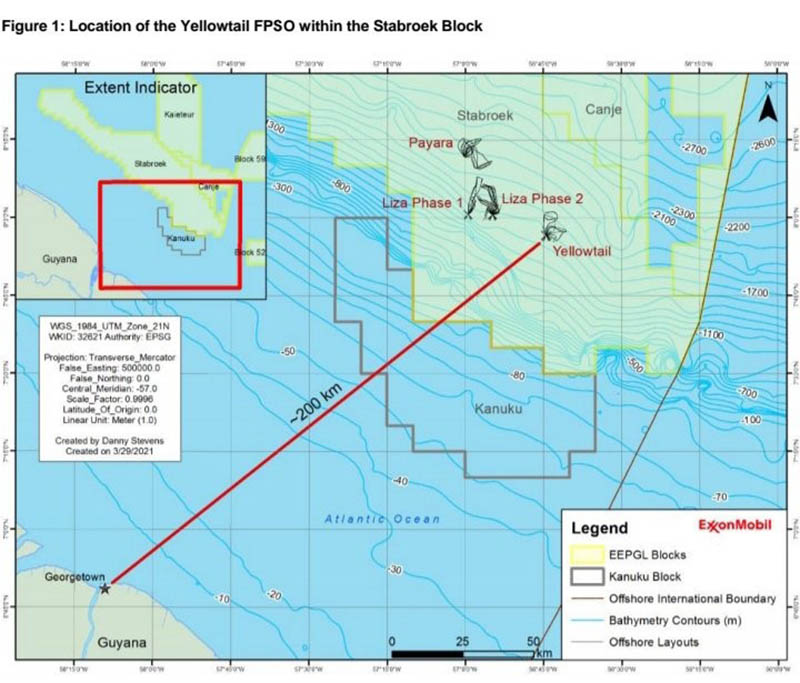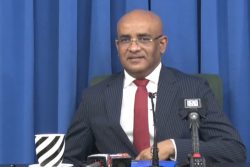A group of citizens has called on the Environmental Assessment Board (EAB) to declare the impact survey for ExxonMobil’s proposed Yellowtail oil well null and void and for the process to be restarted.
Citing unanswered questions and concerns about the consulting firm which did the Environmental Impact Assessment (EIA) for the proposed well, the citizens in letters of December 10th to EAB Head Omkar Lochan and the Executive Director of the Environmental Protection Agency (EPA), Kemraj Parsram called for a “reset” for the application for an environmental authorisation for the project. The EAB presides over appeals of EPA decisions.
The conduct of the EPA in relation to authorisations for the activities of ExxonMobil’s subsidiary, Esso Exploration and Production Guyana Limited (EEPGL) has come under increasing scrutiny from civil society groups and activists. The letters to Lochan and Parsram were signed by Simone Mangaly, Alfred Bhulai, Vanda Radzik, Jatte Bulkan, Danuta Radzik, Jerry Jailall, Alissa Trotz and Maya Trotz.
The period for public feedback on the Yellowtail EIA is set to end tomorrow.
In their letters to the EAB and EPA, the citizens set out a timeline for the EIA done by ERM and called into question whether there had been enough time for it to do a proper study.
“The EEPGL applied for an Environmental Permit for the Yellowtail Development on April 1, 2021. On May 9, 2021 the EPA indicated that an EIA was required. On June 28, 2021, the ERM was approved as the consulting firm to carry out the study, and on September 10, 2021, the EPA issued the Final Terms and Scope for the Yellowtail Development Environmental Impact Assessment. One month later in October, 2021 the ERM submitted its EIA document for the statutory 60-day public scrutiny process, which commenced on October 15, 2021. How could the ERM have possibly done a credible EIA study according to statutory provisions of the Environmental Protection Act within one month of the issuance of the Final Terms and Scope for the study?” the citizens asked.
They said that the public relies on knowledge of the Final Terms and Scope for the Yellowtail Development EIA (DEIA) to make an informed decision on the adequacy of the EIA presented by ERM. Without this the 60-day public comment period would be useless. Yet, they said that the Terms and Scope of the DEIA can be found nowhere. They said that contrary to basic professional practice it was not disclosed in the EIA submitted by ERM.
“Why is this information being withheld from the public by EEPGL and its firm ERM, and the EPA?” they asked in the letters seen by Stabroek News.
They argued that the EAB cannot possibly consider that the current 60-day period for public scrutiny of this EIA is valid when the Final Terms and Scope remains hidden from the public.
“In fact, we submit that that entire process has been miscarried and call upon the EAB to declare it null and void and reset EEPGL’s application for Environmental Authorisation. The ERM’s professional capacity, ethics, and independence from EEPGL are in serious doubt and is evidenced in the poor-quality EIA study that lacked original research on impacts, and the contempt ERM has shown for the people of Guyana by cobbling together … a lengthy EIA document in a mere month without even regard for disclosing the Terms of Scope for works in the document.
“This Yellowtail EIA process is a travesty that, among other things, brings into serious question the conduct of the Environmental Protection Agency and the nature of its relationship with EEPGL and its consulting firm ERM. The EPA must account to citizens for the transgressions it has condoned”, the citizens said.
Evidence
They called for evidence that ERM had been selected via a competitive process and also homed in on an error on the Yellowtail EIA for which ERM has apologised and which the citizens say has called into question the credibility of the consultant.
“Please provide the evidence that ERM was shortlisted by the Environmental Protection Agency among consultants qualified to conduct EIAs through the prescribed process in the Environmental Protection Act, which requires a review of their credentials and capacity by qualified international environmental organisations. Please provide evidence of when this was done for the EPA’s approval of the ERM”, the citizens urged.
They added that the records show that EEPGL has only ever chosen ERM from a list of consultants to conduct all its Environmental Impact Assessments and management plans to date. “Where is the evidence that EEPGL selected the ERM from the pool of EPA approved consultants by open bidding? What evidential basis does the EPA have for determining that ERM is sufficiently independent of EEPGL in accordance with the requirement for independence of consultants in the Environmental Protection Act?” they asked.
The citizens pointed out that ERM admitted in an apology letter carried in the Kaieteur News on November 28, 2021, to placing the signature of People’s Progressive Party Executive Committee Member and well-known Environmental Consultant Shyam Nokta on the cover of the public summary of the Yellowtail EIA without his knowledge or consent.
“How does the EPA view the ERM’s credibility considering this serious breach of professional ethics and public trust?” the citizens further queried.
They also raised the matter of an about-turn by the EPA on new guidelines for EIAs which were in place in 2020 but then suddenly withdrawn. The citizens pointed out that the new guidelines were in effect for a portion of the Yellowtail process and asked whether this was not procedurally unfair.
“The EIA 2020 Guidelines were in effect when EEPGL applied for an Environmental Permit for Yellowtail on April 1, 2021. The public consultation process was launched in May of 2021. The 2020 EIA guidelines were in effect for the 28-day public comment period and were the tool upon which stakeholders relied for their expectations of the standard of work that EEPGL’s consultants would perform. Yet these guidelines were suddenly suspended and pulled from public view and moved off the EPA’s website in June of 2021: Why were they removed without credible explanation, or any effort made to restore them since? Did EEPGL refuse to adhere to the international best practice standards contained in the EPA’s 2020 Guidelines and specifically, the consideration for consultation with affected parties on transboundary impacts?
“How does the EPA justify running the 28-day initial public comment period with these guidelines in effect, but then permitting ERM to revert to the old 2000 guidelines for the conduct of the study? Is this not procedurally unfair and a breach of public trust?” the citizens asked.
They pointed to a variety of other questions which remain unanswered from the public consultation sessions that were held on the Yellowtail EIA including the impacts of the total volume of waste to be brought to shore during the lifetime of the Yellowtail project and baseline information on Guyana’s fisheries sector.










